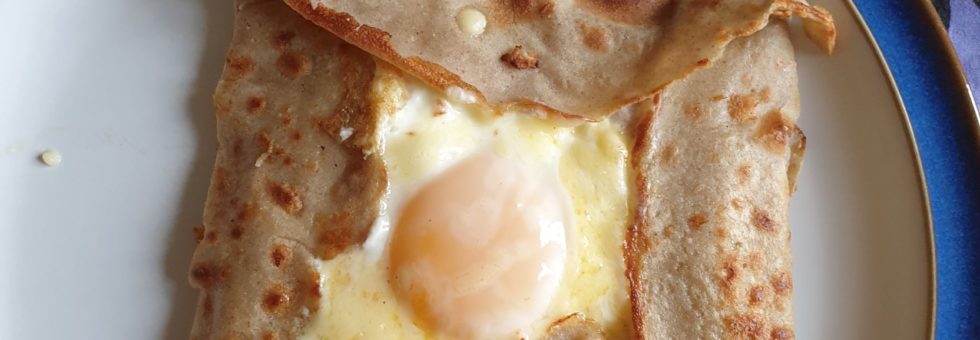It’s pancake day; that crêped up on me…
This week I’m getting into the pancake mood and sampling some French galettes, as opposed to crêpes. Galettes cause all sorts of problems as they have many guises. Wikipedia had some helpful background on the matter, as did fellow culinary translator Hannah Lawrence. The word galette comes from the Norman word gale, meaning ‘flat cake’. Although galettes are many and varied, this goes a long way to explaining the one thing they all have in common: their flat shape.
Different types of galette
The Breton galette is form pancake made using buckwheat flour with savoury toppings.
Another particularly well-known galette is the galette des rois, the French King cake eaten to celebrate Epiphany. It contains a frangipane filling sandwiched between two layers of puff pastry.
The fruit galette has recently gained traction in the UK and is often referred to in English as a rustic tart. It is made by rolling out shortcrust pastry, placing the fruit on top and folding the edges inwards to frame the fruit, before baking. Berries and stone fruit are usually the fillings of choice.
Then there are the galettes campinoises are a type of snack waffle enjoyed in Belgium.
Further galette recipe research online leads me to fritters made with various types of vegetables, such as courgettes.
So there you have it, the flat earth is your oyster!
Cooking
What is the difference between a crepe and a galette?
As mentioned above, galettes are made with buckwheat flour, a gluten-free flour with a nutty texture. They are topped with savoury ingredients and a traditional one, known as a galette complète contains ham and grated cheese in the middle. An egg is then cracked on top and the four sides folded in, so only the yolk is showing. It sounds so easy, but in reality the edges defy gravity and are tricky to keep folded down.
Apart from the buckwheat flour, the other ingredients were pretty standard. Emmenthal cheese is accessible but if you didn’t have it, any melty cheese will do.
Translation
Galettes de sarrasin – strictly speaking they are buckwheat pancakes or crêpes. However, galette is often found in English these days and understandable (once you know which kind of galette we’re talking about!) so I opted for Breton Galettes.
Units were written in in Cl, which I localised to ml for a UK audience. That kind of detail could throw a reader if they are not used to it. Localisation is adapting a translation to a specific country or region. That means not just translating the words, but making it intelligible to the intended audience. You could argue that all translation is localisation, but it’s particularly obvious and important when it comes to recipe translation.
I discovered that there are two ways of referring to buckwheat flour in French: ‘farine de blé noir’ (black wheat flour) and ‘farine de sarrasin’.
When it comes to the filling the recipe says ‘pour une galette complète’, i.e. for a complete galette. I opted for ‘for a traditional filled galette’ to highlight that this was the traditional recipe and that it was filled.
Some recipes use water instead of milk, which makes for a bland result with an unremarkable texture. Made with milk, Breton galettes are superior to ordinary crêpes in my book, with a deliciously savoury, nutty flavour. I’ll definitely be making them again. In the meantime, what to do with the rest of my copious amounts of farine de sarrasin…



